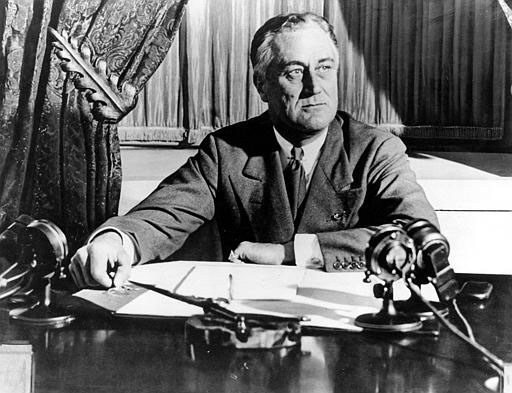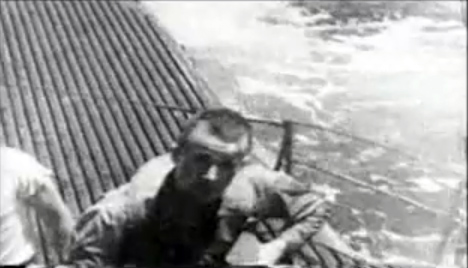The question of whether FDR had prior knowledge of Japan's pending attack on Pearl Harbor before December 7th 1941 has been long debated. Conspiracy theorists, much like after 911, have had a field day with this since that day that lives "in infamy", even accusing the President of devising the attack himself to draw the country into war. But is there any truth to this?

Mirroring its sudden assault against Russia in 1905, Japan was known to attack sneakily and December 7th was just that -- that day FDR was famously asked "how did we get caught with our pants down?" The President didn't have an answer. It was, in effect, an intelligence failure since the US did have critical information that might have been used to predict Japan's move in Hawii, however the information was too convoluted and often dismissed, held by too many different people in different agencies to be put together in time to predict Japan's strike target.
Here is a timeline of the intelligence collecting process in 1941:
- A diplomat reported early that year that Japan had chosen Pearl Harbor as a target if the US caused any trouble for their empire. However, the diplomat also described it as "fantastic".
- The State Department warned prior to September 1941 that embargoes of Japan would lead to the US "getting involved in war," however, the US proceeded with an oil embargo.
- A US double agent had advised FBI director J. Edgar Hoover that the Japanese had studied the logistics of effective air raids in Italy, forecasting that it was planning an attack.
- The same double agent revealed that he was instructed to monitor Pearl Harbor and report details about torpedo protection nets, amongst other US defenses.
- British XX (Double Cross Committee) Chairman JC Masterman concluded that Pearl Harbor would be the first target in the event of war between the US and Japan. He did not communicate this conclusion to the US.
- J. Edgar Hoover dismissed the information in point #3 and #4 and and never reported it to the President.
- A decoded message from the Japanese revealed that it would not be "strangled" if the US did not meet their deadline for signing an agreement on the embargo. It also said that "things are automatically going to happen" after the deadline passed. This was forwarded to the President.
- FDR met with his War Council, warning that the Japanese may attack as early as Dec. 1, without warning. War Secretary Henry Stimson wrote that, "the question was how to maneuver them into the position of firing the first shot without allowing too much danger to ourselves."
- Admiral Stark hi-lighted numerous potential targets for attack for the President, however they did not include Pearl Harbor. The attack site was expected to be elsewhere.
- FDR chose to keep a coded decrypt that included Japans cables to Germany, predicting that War was about to break out.
- The Chief of Naval Intelligence intercepted arial views of Pearl Harbor that had been sent to Japan, but didn't relay the information to the President, believing that the Japanese were using the photos to ascertain how quickly the US would respond to an attack in Southeast Asia.
- FDR appealed directly to Emperor Hirohito to restore amity between the two nations.
- The Army and Navy had split code breaking responsibilities alternating the responsibility day to day, on December 6th, the Army was left to decode a message intercepted by the Navy, which wasted precious time.
- When the message was finally decoded, it was promptly sent to the White House. Given to a young Lieutenant on his second day on the job, it was finally delivered it to FDR who reflected aloud, "this means war". The cable did not include a target or that the attack would come the following day.
- A final cable was decoded on December 7th showing an impending attack but officials concluded that it implied an attack on the Phillippines. The message was delayed because General Marshall was on his routine Sunday horseback ride. Further delaying its distribution was the fact that it was sent to Manilla, first, then to the Panama Canal, and then to Hawii. By the time word of this cable arrived at Pearl Harbor, it was too late.
President Roosevelt knew that Japan planned to attack, but didn't know where. While the US had information about Pearl Harbor, it never reached FDR in a way that would have made a material difference in our War preparedness. For more, read Joseph E. Persico's book Roosevelt's Secret War.
 Saturday, February 12, 2011 at 3:41PM
Saturday, February 12, 2011 at 3:41PM 
 George HW Bush,
George HW Bush,  WWII
WWII  Saturday, February 12, 2011 at 3:41PM
Saturday, February 12, 2011 at 3:41PM 
 George HW Bush,
George HW Bush,  WWII
WWII  Tuesday, December 7, 2010 at 3:11PM
Tuesday, December 7, 2010 at 3:11PM 
 FDR,
FDR,  Intelligence,
Intelligence,  Pearl Harbor,
Pearl Harbor,  WWII
WWII